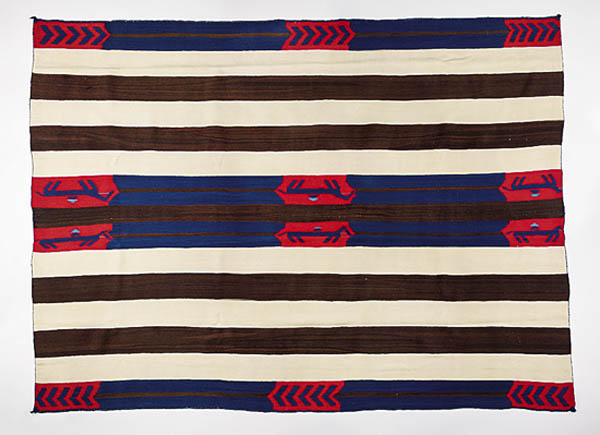"Navajo Weavings: Tradition And Trade"
Unique Exhibit Of Southwestern American Art On View At Art Museums Of Colonial Williamsburg
On Saturday, July 14, the Abby Aldrich Rockefeller Folk Art Museum, one of the Art Museums of Colonial Williamsburg, opens Navajo Weavings: Tradition and Trade, an exceptional opportunity to view 26 examples of these colorful and symbolic items on loan from the collection of American folk art enthusiasts Pat and Rex Lucke. The exhibition is scheduled to remain on view until May 31, 2020. Through the woven motifs of these textiles, museum visitors can learn what was important to the makers among the Diné (the term the Navajo use to refer to themselves meaning the People) and gain a sense of their aspirations.
As Colonial Williamsburg continuously strives to illustrate Americas enduring history, it is especially significant to be able to share with our visitors this extraordinary collection of American Indian textiles, said Mitchell B. Reiss, president and CEO of the Colonial Williamsburg Foundation. The motifs in these weavings will offer our guests important awareness of this vibrant culture through their artistic traditions.
The Art Museums of Colonial Williamsburg strive to present exhibitions that address the broad range of American culture, said Ronald L. Hurst, the foundations Carlisle H. Humelsine chief curator and vice president for collections, conservation and museums. We are particularly pleased to share this important body of Navajo weavings from the Southwest with our audiences and are grateful to Mr. and Mrs. Lucke for their generous loan.
The earliest of Navajo weavings were blankets to be worn, known as chief blankets, made with a simple horizontally striped and banded design and format. Among the highlights of Navajo Weavings is the oldest known remaining Navajo blanket that contains pictorial elements. This example, made between 1855 and 1865 of native handspun wool, bayeta (raveled wool trade cloth that was used to create the red color) and natural dye, is elegant in its simplicity and classic proportions. The anonymous weaver used traditional formations found in the classic style of its time period showing black and white stripes. The weaver also had the freedom to individualize the piece with personal experiences and outside influences from trade. Six stylized horses, symbols of power and wealth, in the center horizontal anchor points are the exception to the traditional design in this piece. The horses are stylistically similar to those found on early Navajo petroglyphs dating to 1800. Many weavings created in the late 19th and early 20th centuries included imaginatively stylized horse images, signifying their importance to the Diné. After Spanish Conquistadors introduced horses to the Southwest in the 17th century, the Peoples way of life was forever changed as horses were used for transportation, warfare and commerce.
Navajo pictorial weavings provide an insight into the cultural changes of the Diné and a record of their daily life, said Kimberly Smith Ivey, senior curator of textiles at Colonial Williamsburg. The Navajo weaver integrated traditional Diné imagery and symbolism with images of modern life influenced by trade and other cultures. The best examples reveal aspects of the artists personality and imagination, such as an independent spirit and sense of humor.
Almost all Navajo pictorial weavings show objects or scenes that are common on the native lands and combine objects from modern, everyday life with traditional imagery. Another highlight in this extraordinary collection to be on view is a small woven example made of commercial wool, cotton and dye from ca. 1890. Tradition meets trade in this piece that depicts corn, a sacred plant used in Navajo ceremonies, and a modern locomotive. Small weavings such as this one, called samplers or loom samplers, were produced by Navajo weavers as unfinished works-in-progress on looms and as finished textiles. These smaller objects were popular with tourists because they were less expensive and could be easily transported.
Although the American flag was favored by customers, it rarely appears as a true rendering on Navajo weavings. As flags were displayed on government buildings, both the buildings themselves as well as the flags became symbolic of U.S. power and authority on Navajo land. The weavers, therefore, would have adapted the flag to suit their needs, sometimes altering the rectangular shape, changing the number of stars or substituting them with flowers or anchors to create an entirely different motif. The colors might not have remained red, white and blue. In yet another eye-catching example in Navajo Weavings, a pictorial weaving made between 1910 and 1920 of commercial wool and dye features the American flag along with a building, probably representing a school house, that stood out on Navajo land as a symbol of the governments authority. The size and shape of the piece suggest that it may have been intended for use as a table runner.
Collectors Pat and Rex Lucke have been fascinated for many years with the artistic expression of Navajo weavers and understand that in the hands of these anonymous women, everyday objects such as trains, livestock and houses become works of art. The Luckes, who began collecting antiques, folk art and other artifacts in the early 1970s, discovered Navajo weavings while visiting an Indian arts gallery in Scottsdale, Ariz., and thought it would be a fitting addition to their folk art collection. Today, the Luckes enjoy living among their collections in their Nebraska home.
Navajo Weavings: Tradition and Trade is generously funded by an anonymous donor. For American Indian art aficionados, textile admirers, folk art enthusiasts and anyone who appreciates design and Navajo culture, Navajo Weavings is an exhibition not to be missed.
Colonial Williamsburg and Art Museums tickets and additional information are available online at www.colonialwilliamsburg.com, by calling 855-296-6627 and by following Colonial Williamsburg on Facebook and @colonialwmsburg on Twitter and Instagram.
Images courtesy of The Art Museums of Colonial Williamsburg/The Lucke Collection.











